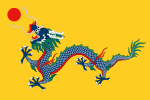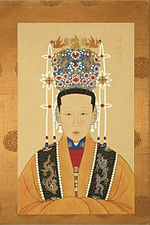 | Wuxing (Chinese: 五行; pinyin: wǔxíng), usually translated as Five Phases or Five Agents, is a fivefold conceptual scheme used in many traditional Chinese... 32 KB (2,252 words) - 16:14, 5 May 2024 |
matter's dying or hiding stage. Water is the fifth of the five elements of wuxing. Among the five elements, water is the most yin in character. Its motion... 3 KB (315 words) - 00:53, 31 March 2024 |
In Chinese philosophy, metal or gold (Chinese: 金; pinyin: jīn), the fourth phase of Wu Xing, is the decline of the matter, or the matter's decline stage... 4 KB (526 words) - 14:27, 16 February 2024 |
In Chinese philosophy, wood (Chinese: 木; pinyin: mù), sometimes translated as Tree, is the growing of the matter, or the matter's growing stage. Wood... 4 KB (477 words) - 05:11, 1 April 2024 |
In Chinese philosophy, earth or soil (Chinese: 土; pinyin: tǔ) is the changing or central point of physical matter or a subject. Earth is the third element... 4 KB (586 words) - 21:02, 17 March 2024 |
Look up wuxing in Wiktionary, the free dictionary. Wuxing may refer to: Huzhou, formerly Wuxing County, Zhejiang, China Wuxing District (吴兴区), central... 2 KB (212 words) - 17:02, 24 January 2023 |
In Chinese philosophy, fire (Chinese: 火; pinyin: huǒ) is the second phase of Wu Xing. Fire is yang in character. Its motion is expanding and its energy... 5 KB (616 words) - 14:27, 16 February 2024 |
religions. The Japanese Buddhist concept of gogyo, which stems from Chinese wuxing, is distinguishable from godai by the fact that the functional phases... 13 KB (1,502 words) - 18:08, 3 February 2024 |
 | and jade. Hairpins are an important symbol in Chinese culture, and are associated with many Chinese cultural traditions and customs. They were also... 19 KB (1,832 words) - 14:08, 30 November 2023 |
Specifically, it combines the use of Chinese freehand brush work techniques and the metaphysics of the five wuxing elements. Wuxing painting also inherited some... 3 KB (338 words) - 07:14, 15 February 2024 |
Five elements (section Philosophy) Classical elements Godai (Japanese philosophy) Gogyo, five phase Japanese philosophy Wuxing (Chinese philosophy), ancient Chinese theory involving five 'phases'... 847 bytes (115 words) - 17:29, 25 April 2024 |
 | creed of etiquette for Chinese society. The debate over whether the thought of ancient Chinese masters should be called philosophy has been discussed since... 41 KB (4,890 words) - 17:45, 2 May 2024 |
 | Rabbit (zodiac) (redirect from Rabbit (Chinese zodiac)) the Chinese zodiac related to the Chinese calendar. The Year of the Rabbit is associated with the Earthly Branch symbol 卯. the element Wood in Wuxing theory... 5 KB (222 words) - 17:38, 30 April 2024 |
Element (section Philosophy and religion) Hindu Samkhya philosophy Wuxing (Chinese philosophy), sometimes translated as five elements, the basis of the universe according to Chinese Taoin Element... 6 KB (673 words) - 16:47, 8 February 2024 |
 | Classical element (category Concepts in Chinese philosophy) or prime matter Qi – Vital force in traditional Chinese philosophy Wuxing (Chinese philosophy) – Chinese five elements Thera (1956), pp. 318–320: "the atomic... 41 KB (4,260 words) - 12:54, 6 May 2024 |
 | Hanfu (redirect from Han Chinese costume) (simplified Chinese: 汉服; traditional Chinese: 漢服; pinyin: Hànfú, lit. "Han clothing"), are the traditional styles of clothing worn by the Han Chinese. There... 264 KB (30,096 words) - 21:19, 10 May 2024 |
 | including the traditional Chinese marriage. There are various forms of traditional Chinese wedding dress in the history of China. Since the Zhou dynasty... 11 KB (990 words) - 18:48, 30 January 2024 |
Visualization Water cure (therapy) Wellness (alternative medicine) Wuxing (Chinese philosophy) Yoga Ashtanga yoga Ashtanga vinyasa yoga Bikram yoga Hatha yoga... 7 KB (405 words) - 00:42, 10 April 2024 |
 | Confucianism (redirect from Confucian philosophy) JSTOR 24047638. Zhou (2012), p. 1. Littlejohn, Ronnie. "Wuxing (Wu-hsing)". Internet Encyclopedia of Philosophy. ISSN 2161-0002. Retrieved 30 April 2023. Nylan... 128 KB (15,158 words) - 01:57, 10 May 2024 |
Taoist philosophy (Chinese: 道家; pinyin: Dàojiā; lit. 'Tao school') also known as Taology refers to the various philosophical currents of Taoism, a tradition... 35 KB (4,263 words) - 20:58, 20 February 2024 |
 | Huadian (make-up) (category CS1 Chinese (China)-language sources (zh-cn)) (traditional Chinese: 花鈿; simplified Chinese: 花钿), also known as huazi (Chinese: 花子; lit. 'Little flower'), mianhua (Chinese: 面花), meizi (Chinese: 媚子), plum... 14 KB (1,375 words) - 00:39, 29 February 2024 |
 | The Chinese Empire, also known as Imperial China, Empire of China, Celestial Empire, or simply China, was an imperial realm that spanned much of East,... 311 KB (34,793 words) - 19:11, 10 May 2024 |
Hanfu footwear (category Chinese footwear) Chinese dress : from the Qing Dynasty to the Present. Tokyo: Tuttle Pub. ISBN 978-0-8048-3663-0. OCLC 154701513. Jin, Zhilin; 靳之林. (2004). Chinese folk... 9 KB (434 words) - 21:38, 27 September 2023 |
Pibo (category Articles containing Chinese-language text) Pibo (Chinese: 披帛), also called Pizi (Chinese: 帔子), is a type of decorative silk shawl accessory for Hanfu. It was introduced to China through the Silk... 4 KB (437 words) - 18:09, 12 March 2024 |
 | Hu (ritual baton) (category Articles containing Chinese-language text) A hu (Chinese: 笏; pinyin: hù) is a flat scepter originating from China, where they were originally used as narrow tablets for recording notes and orders... 12 KB (1,257 words) - 22:49, 4 February 2024 |
 | Fengguan (category Articles containing Chinese-language text) Fengguan (Chinese: 鳳冠; pinyin: fèngguān), also known as phoenix coronet or phoenix hat, is a type of guan (a type of Chinese traditional headgear) for... 12 KB (1,174 words) - 08:54, 6 April 2024 |




